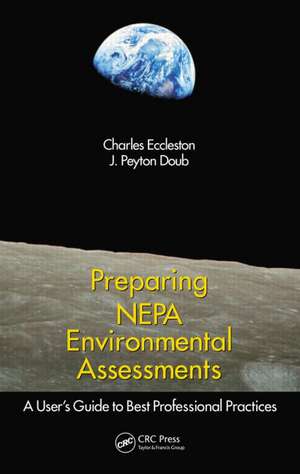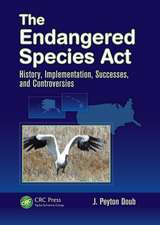Preparing NEPA Environmental Assessments: A User’s Guide to Best Professional Practices
Autor Charles Eccleston, J. Peyton Douben Limba Engleză Hardback – 8 mai 2012
Bridging the regulatory gap, this book identifies relevant EIS regulatory requirements that can be logically interpreted to also apply to EAs. It compiles and synthesizes information scattered throughout NEPA’s regulations, executive orders, and guidance documents, and incorporates case law to provide additional clarification. The authors also draw on the professional experiences and best professional practices (BPP) of NEPA practitioners.
From the fundamentals to more advanced topics, the book presents a consistent methodology to help beginners, students, and professionals manage, analyze, and write legally sufficient EAs. It addresses dilemmas that have traditionally plagued preparation of EAs, provides BPPs, tools, and approaches for resolving problems, and introduces methods for streamlining the EA process.
Building on Eccleston’s previous guide to EAs, Effective Environmental Assessments: How to Manage and Prepare NEPA Assessments (2001), this book reflects the rapid changes in government policy over the past ten years. An indispensable source of practical information, it provides readers with step-by-step direction and best practices for preparing defensible EAs.
| Toate formatele și edițiile | Preț | Express |
|---|---|---|
| Paperback (1) | 461.07 lei 6-8 săpt. | |
| CRC Press – 31 mar 2017 | 461.07 lei 6-8 săpt. | |
| Hardback (1) | 1113.12 lei 6-8 săpt. | |
| CRC Press – 8 mai 2012 | 1113.12 lei 6-8 săpt. |
Preț: 1113.12 lei
Preț vechi: 1357.46 lei
-18% Nou
Puncte Express: 1670
Preț estimativ în valută:
212.99€ • 222.38$ • 176.28£
212.99€ • 222.38$ • 176.28£
Carte tipărită la comandă
Livrare economică 05-19 aprilie
Preluare comenzi: 021 569.72.76
Specificații
ISBN-13: 9781439808825
ISBN-10: 1439808821
Pagini: 316
Ilustrații: 7 b/w images and 61 tables
Dimensiuni: 156 x 234 x 23 mm
Greutate: 0.57 kg
Ediția:Revizuită
Editura: CRC Press
Colecția CRC Press
Locul publicării:Boca Raton, United States
ISBN-10: 1439808821
Pagini: 316
Ilustrații: 7 b/w images and 61 tables
Dimensiuni: 156 x 234 x 23 mm
Greutate: 0.57 kg
Ediția:Revizuită
Editura: CRC Press
Colecția CRC Press
Locul publicării:Boca Raton, United States
Public țintă
Environmental assessors, Agency decisionmakers, Environmental engineers, Environmental attorneys, Program and project planners, Environmental scientists and analysts, Environmental regulators, Environmental advisors, Private environmental contractors and consultantsCuprins
The NEPA Environmental Assessment Process: Overview and Historical Development of NEPA. General Concepts and Requirements. NEPA and Environmental Impact Analysis. The Threshold Question: Determining Whether an EA or an EIS is Required. The Environmental Assessment Process. The Environmental Impact Assessment. Writing the Environmental Assessment. Assessing Significance. The Finding of No Significant Impacts. NEPA Case Law and Non-NEPA Environmental Assessment Documents: An Overview of NEPA Law and Litigation. Specialized Non-NEPA Environmental Assessment Documents. Summary. Index.
Notă biografică
Charles H. Eccleston is listed in Marquis’ Who’s Who in the World and Who’s Who in America as a nationally recognized NEPA authority. He is a consultant, author, and lecturer with some 30 years experience in NEPA, environmental policy, and analyzing the impacts of projects and energy-related policies. He also frequently consults on NEPA lawsuits. He is the author of nine books and 80 professional publications. Some of his recent books include:
- Environmental Impact Assessment: A Guide to Best Professional Practices
- Inside Energy: Developing and Managing an ISO 50001 Energy Management System
- Global Environmental Policy: Concepts, Principles, and Practice
- NEPA and Environmental Planning: Tools, Techniques, and Approaches for Practitioners
Recenzii
Praise for the previous book, Effective Environmental Assessments: How to Manage and Write NEPA Assessments (CRC Press, 2001):
"Mr. Eccleston has written a most thorough guide to managing and preparing EAs that puts NEPA back into its original perspective—a planning and decision-making tool … comprehensively covers the EA process … provides practical guidance for effectively preparing an analysis …"
—Mr. Russell W. Peterson, Former Governor of Delaware and Former Chairman of the Council on Environmental Quality (CEQ)
"NEPA is the cornerstone of our environmental statutory structure and provides a strategic look for long-range planning. By explaining the environmental assessment process in a scholarly, yet easily understandable way, Charles Eccleston has performed an enormous service for all who care about the protection of our country's—and indeed the world's—environment."
—Michael R. Deland, Former Chairman, Council on Environmental Quality
"Charles Eccleston has performed a real service in authoring Effective Environmental Assessments: How to Manage and Write NEPA Assessments. The book fills a void and concentrates on environmental assessments, a critical but underemphasized part of the NEPA process. It is, furthermore, both useful and user-friendly."
—Nicholas C. Yost, Sonnenschein Nath & Rosenthal, former General Counsel of the CEQ charged with responsibility for writing the 1978 CEQ NEPA Regulations
"Mr. Eccleston has written a most thorough guide to managing and preparing EAs that puts NEPA back into its original perspective—a planning and decision-making tool … comprehensively covers the EA process … provides practical guidance for effectively preparing an analysis …"
—Mr. Russell W. Peterson, Former Governor of Delaware and Former Chairman of the Council on Environmental Quality (CEQ)
"NEPA is the cornerstone of our environmental statutory structure and provides a strategic look for long-range planning. By explaining the environmental assessment process in a scholarly, yet easily understandable way, Charles Eccleston has performed an enormous service for all who care about the protection of our country's—and indeed the world's—environment."
—Michael R. Deland, Former Chairman, Council on Environmental Quality
"Charles Eccleston has performed a real service in authoring Effective Environmental Assessments: How to Manage and Write NEPA Assessments. The book fills a void and concentrates on environmental assessments, a critical but underemphasized part of the NEPA process. It is, furthermore, both useful and user-friendly."
—Nicholas C. Yost, Sonnenschein Nath & Rosenthal, former General Counsel of the CEQ charged with responsibility for writing the 1978 CEQ NEPA Regulations
Descriere
The National Environmental Policy Act (NEPA) regulations provide surprisingly little direction for preparing environmental assessments (EA). This book addresses this problem by providing a step-by-step guide for preparing EAs. Bridging the regulatory gap, it draws on information scattered throughout NEPA regulations and guidance documents, as well as best professional practices (BPP) and case law. The book progresses from the fundamentals to successfully more advanced topics, making it suitable for beginners, students, and experienced practitioners alike. It provides an indispensable guide for managing, analyzing, and writing legally defensible EAs.










